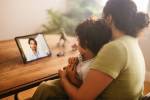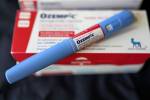Keep the holiday season safe for kids
It’s a magical time of year, and — not to be a downer or anything — a potentially dangerous one for kids, too.
So … happy holidays?
The delights of the season, from colorful decorations placed around the home to the toys sitting under the tree, coupled with the distractions and stresses of the season, can result in Yuletide medical emergencies.
Medical mishaps can occur at any time of the year. But, says Dr. Noah Kohn, assistant dean for clinical faculty development at Touro University Nevada College of Osteopathic Medicine, “I think there are certainly new elements introduced into the child’s environment at the holiday time.
“All of the normal things shouldn’t be forgotten about, whether it’s car seat safety or all of the other things we normally counsel parents on. Those don’t go away. But, yes, there is an increase of new things.”
The American Academy of Pediatrics offers parents a wealth of child safety information on its website (www.healthychildren.org), including advice specific to the year-end holidays. In the meantime, here are a few ways parents can keep “ho, ho, ho” from turning into “help, help, help” this holiday season.
TREES AND DECORATIONS
First, if you opt for a live Christmas tree, buy one that’s healthy and keep it watered. If an artificial tree is more your style, make sure it’s listed as fire-resistant.
Either way, make sure the decorations you place on it don’t have sharp edges, and make sure they’re not breakable. Be wary of ornaments, miniature tree light bulbs and touches — creche figures, for example — that contain small or easily broken-off parts that can become choking hazards.
Dr. Johnn Trautwein, medical director of the pediatric emergency department at Summerlin Hospital, also recommends avoiding decorations that look like, or that a child might mistake for, candy or food.
Keep electrical lights and electrical wires out of children’s reach. Block unused electrical outlets to ensure that kids can’t stick something into the socket and get electrical burns, Trautwein says.
Also be careful of uninflated or popped balloons, tags, strings and ribbons, all of which also can be choking hazards. A good rule of thumb, Kohn says, is that if it’s small enough to fit through the center of a roll of toilet paper, it could be choked on.
Never leave lighted candles unattended, and keep them out of reach of children.
“Of course, with Hanukkah, we have a lot of candles,” Kohn says. “So this would be common sense. But lighted candles shouldn’t be left burning.”
Also keep decorative holiday plants out of a child’s reach. Some — mistletoe berries, Jerusalem cherry and holly berries — can be noxious or poisonous, Kohn says.
Use space heaters only in areas with good ventilation, Trautwein says, and make sure the younger kids do not burn themselves.
Finally, as presents are being unwrapped, collect wrapping paper, ribbons and other materials that can become choking or suffocation hazards.
TOYS AND GAMES
Toy-related injuries accounted for more than a quarter-million emergency room visits last year, Kohn says, and a lot of those (were) related to scooters.
“Scooters are the No. 1 cause of broken bones in children,” Kohn says. “They’re actually incredibly dangerous.”
Unlike bicycles, which are ridden while sitting down, scooters are meant to be ridden standing up.
“If you’re standing up, that’s where the hazard increases,” he says, “whether it’s a skateboard or Rollerblades or roller skates.
“(So) it’s really important that kids who are using these wear all of the appropriate safety gear — helmets, wrist guard, elbow pads, knee pads,” Kohn added. “And really, I, personally, don’t recommend these kind of devices to kids younger than 10.”
Also make sure kids wear appropriate safety gear while skiing, skating or snowboarding, Trautwein says, and kids who receive bicycles or skateboards under the tree also should receive the full complement of necessary safety gear.
“Parents don’t think about that,” he says. “So they get the bicycle or the skateboard or the scooter, and they don’t buy the helmet. So make sure that you’re thinking about the safety equipment as well.”
When buying any toy, follow the age guidelines on the package.
“So many times, parents ignore the age recommendation,” Kohn says, “because they say, ‘I played with that when I was a kid and I did fine,’ or ‘My kids are advanced.’ ”
But, he says, even the most advanced kid will revert to age-appropriate behavior.
“So, even though your toddler may be really articulate and may be advanced in speech development, it doesn’t mean they’re not going to put something in their mouth,” he says. “That’s where age guidelines come in.”
Avoid toys with small pieces — including, for example, game pieces or doll accessories — for younger children. The danger isn’t just choking, Kohn says, but aspiration, in which a child breathes a piece in and his airway becomes blocked.
Understand that toys that might be fine for older kids may not be suitable for younger siblings, and it’s always wise to assume that younger kids inevitably will find their older sibs’ toys. So, make sure potentially hazardous older kids’ toys are kept where younger kids can’t get to them.
Trautwein recommends avoiding projectile toys; Kohn recommends against giving younger kids toys that involve electricity. At the same time, he says, make sure that the batteries in battery-operated toys are in kid-safe compartments that a kid can’t open. Ingested batteries — including small, easily swallowed button batteries of the type used in some toys and even in greeting cards — “can be very dangerous if swallowed,” Kohn says.
Similarly, be wary of magnets and toys with magnets that a child might swallow. Beyond the choking and aspiration hazards they pose, ingested magnets can draw together inside the body and “literally bore a hole through the two pieces of gut and cause bowel perforations,” Kohn says.
The swallowing of batteries or magnets requires immediate medical attention, and Trautwein recommends seeing a doctor even if you merely suspect that a child may have swallowed something.
“If you notice a child has an episode of choking or coughing but seems to get better, you probably want that investigated at the very least with your primary care doctor to get an X-ray,” Trautwein says.
COOKING, DINING AND VISITING
Food safety isn’t a concern in the summer alone. So, keep hot foods hot and cold foods cold, keep food prep areas clean, and follow all of the usual food safety protocols and keep pans away from the edges and corners of stoves and knives and appliances out of kids’ reach.
Do the same at others’ homes, too, and never assume that the homes you visit have been childproofed. So, keep an eye out for such hazards as unlocked cabinets, ignored purses, and harmful cleaners or products stored in kid-accessible places.
It’s the same for firearms, Kohn says.
“Most parents take reasonable precautions,” he says, but don’t assume that’s the case in households without children.
Make sure medications are kept out of children’s reach.
“We saw it over Thanksgiving,” Trautwein says. “The grandparent or relative who’s on blood pressure medication, and especially the diabetes medications, they set down their purse and the inquisitive toddler gets in and, next thing you know, they’ve passed out on the floor and the parents (are calling) poison control.”
If a child has food allergies, be sure that food prepared in restaurants or by family members or friends are safe for the child to eat.
“Nut allergies and things of that nature are the No. 1 culprit,” Trautwein says.
Keep an eye on kids when visiting homes with pools.
“Believe it or not, we still do occasionally see a near-drowning or drowning” during the winter months, Trautwein says.
Just recently, he adds, a child who wandered through an open door and fell into a pool had to be treated. The child didn’t drown, he says, but came in very hypothermic.
Use a car seat when traveling, but understand that strapping in a child who’s wearing a bulky snowsuit or several layers of thick clothing can make the straps fit incorrectly.
So, the academy says, in cold weather, children should wear thin layers with a blanket over the top of the harness straps, and not a thick coat or snowsuit. (More information is available at www.healthychildren.org/carseatguide).
Contact reporter John Przybys at jprzybys@reviewjournal.com or 702-383-0280.




























